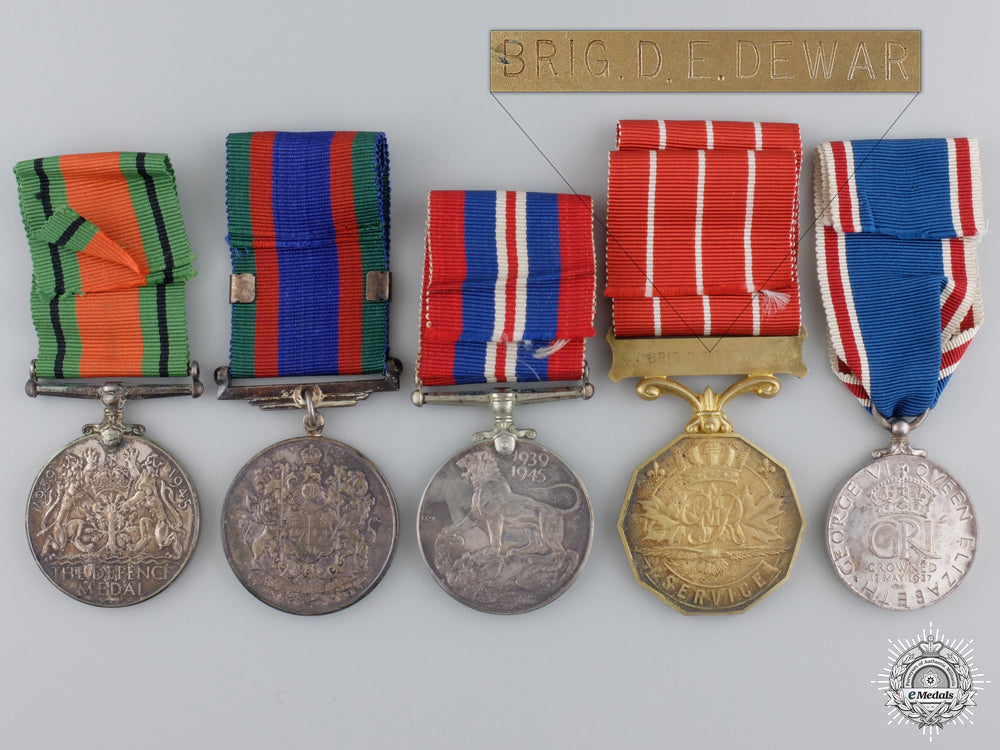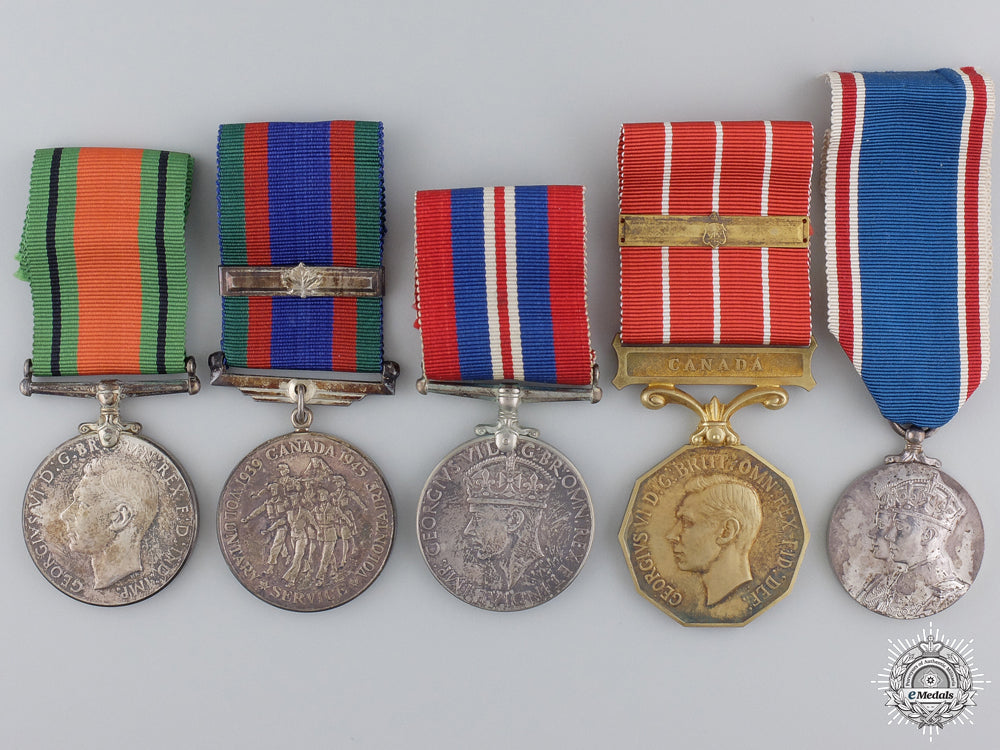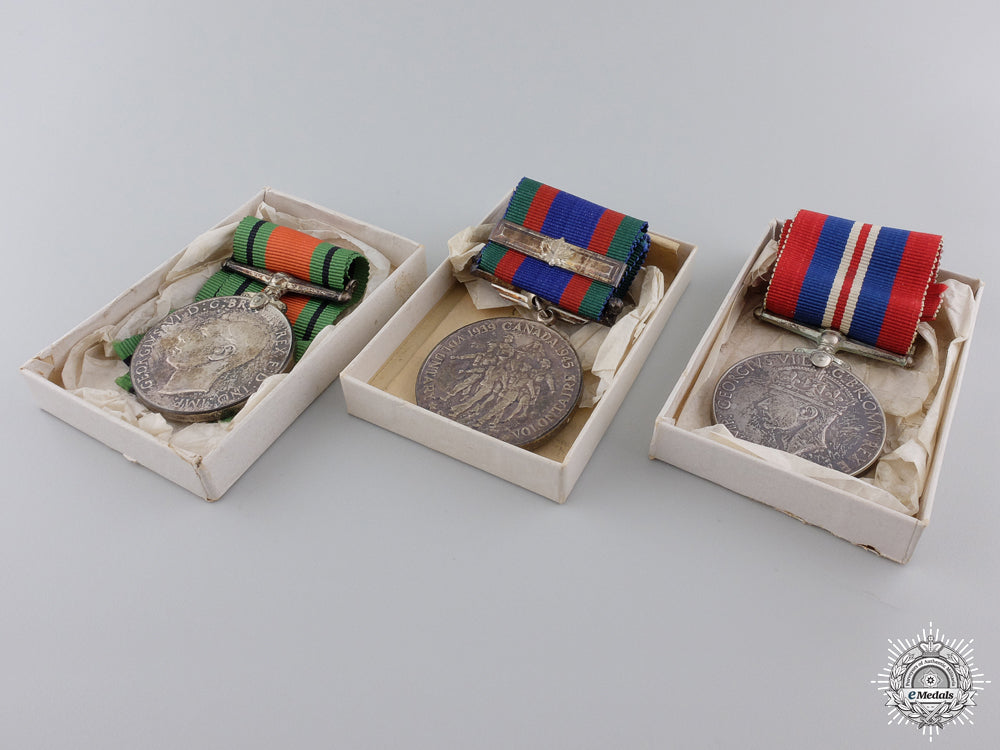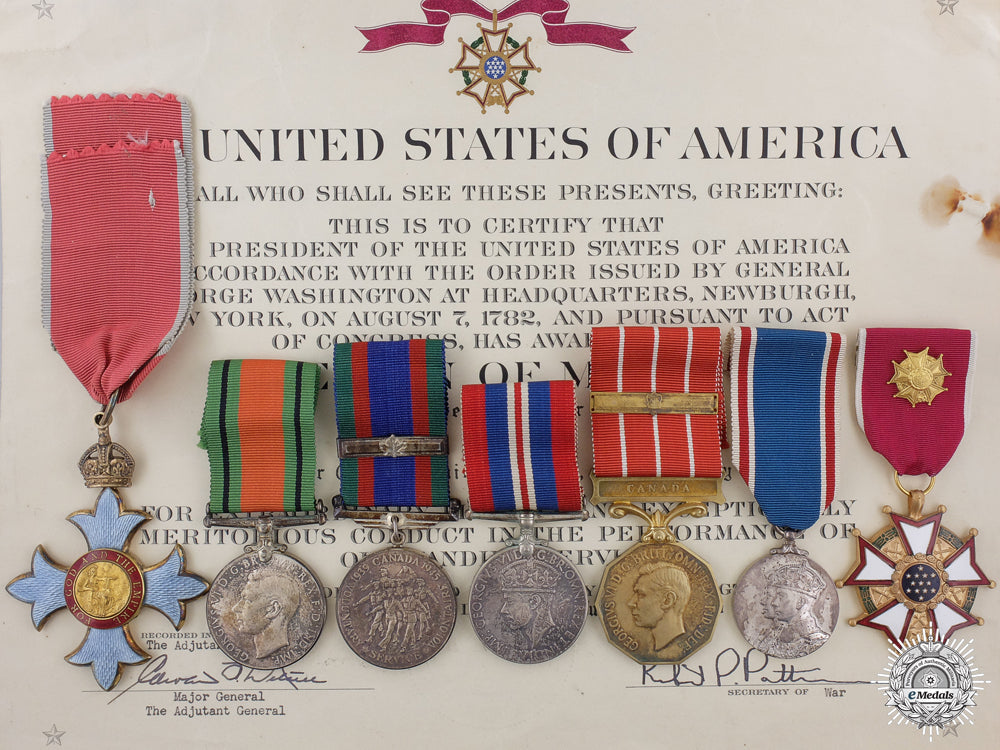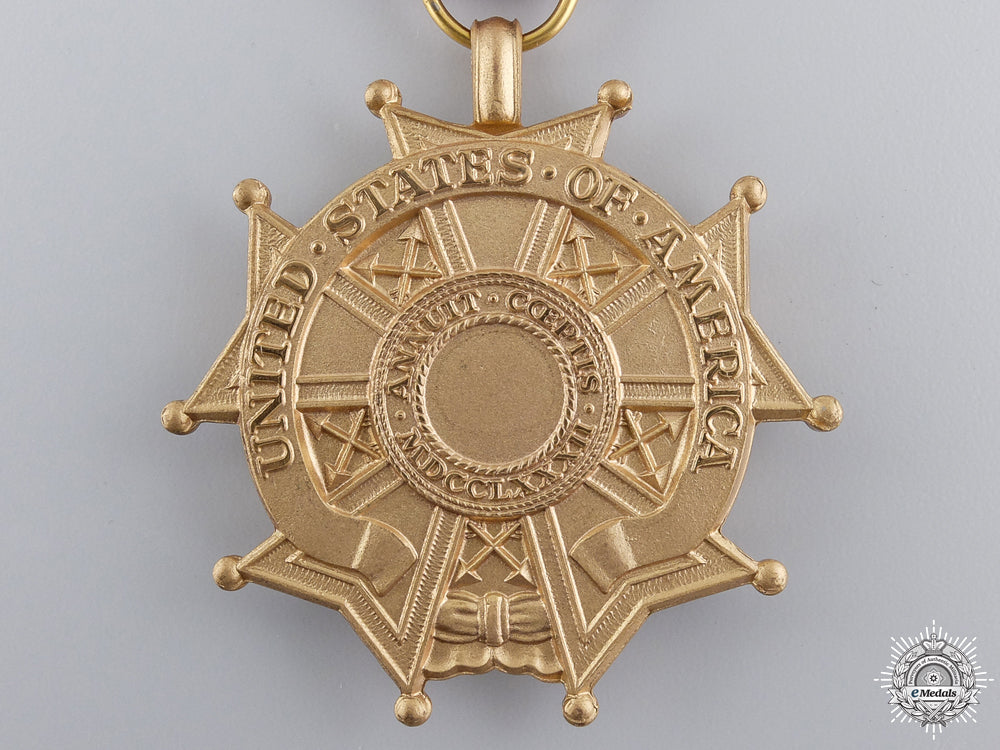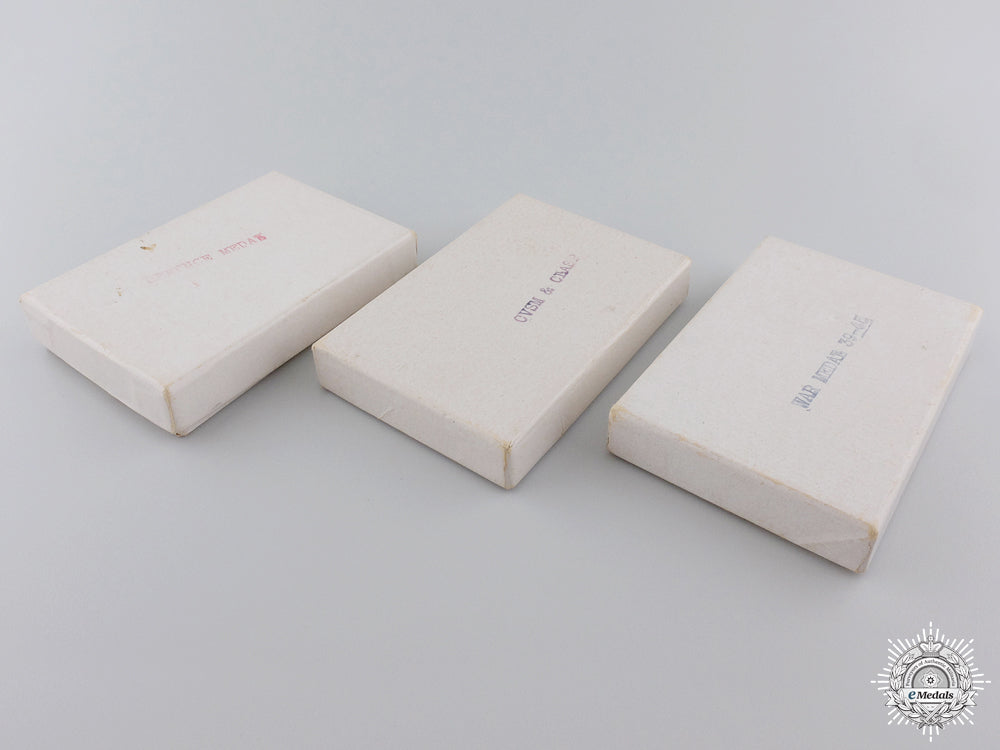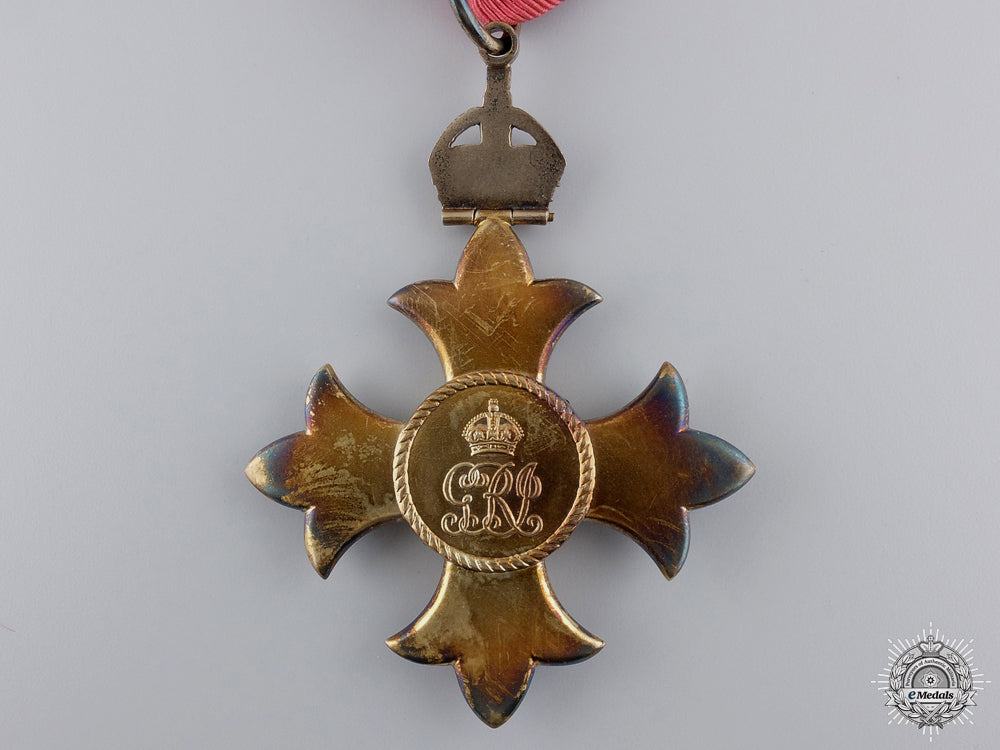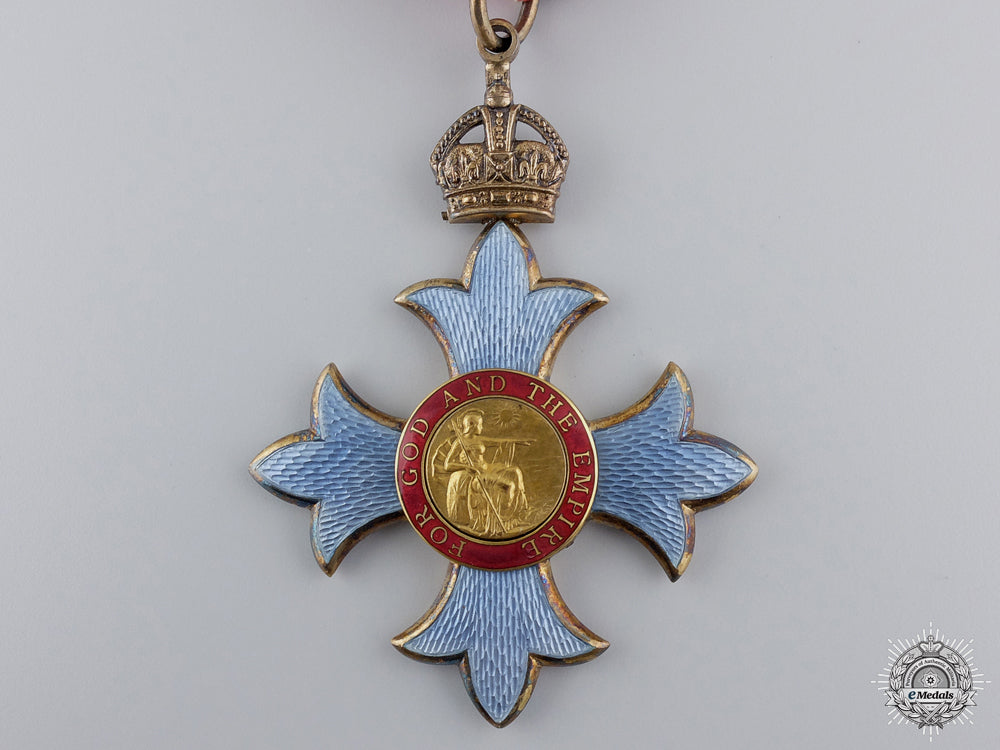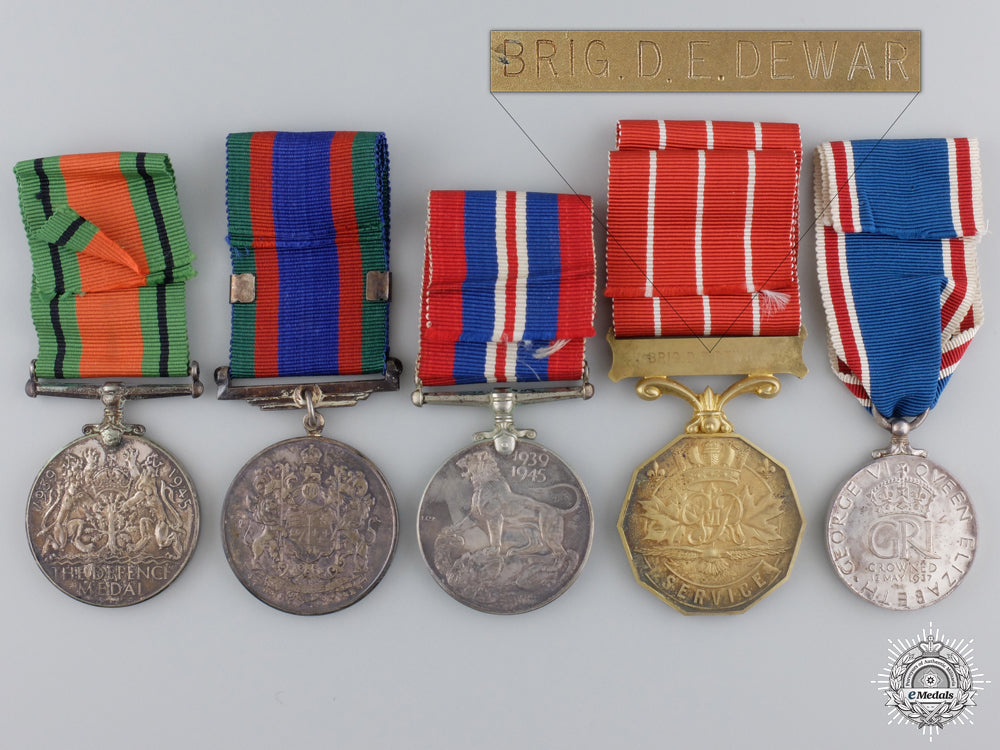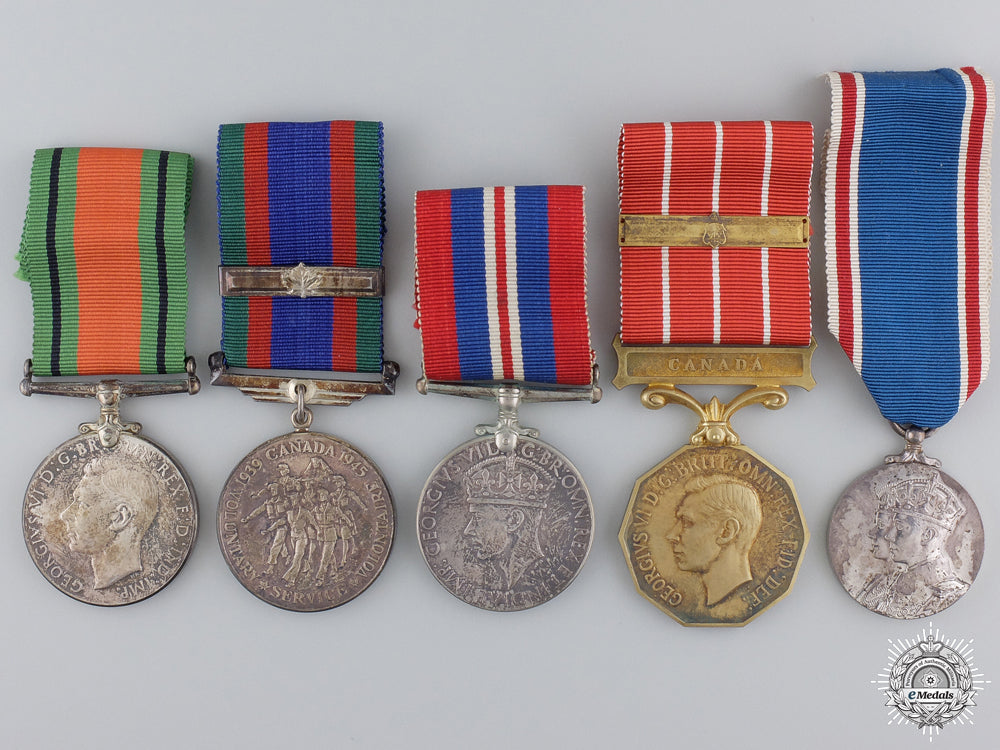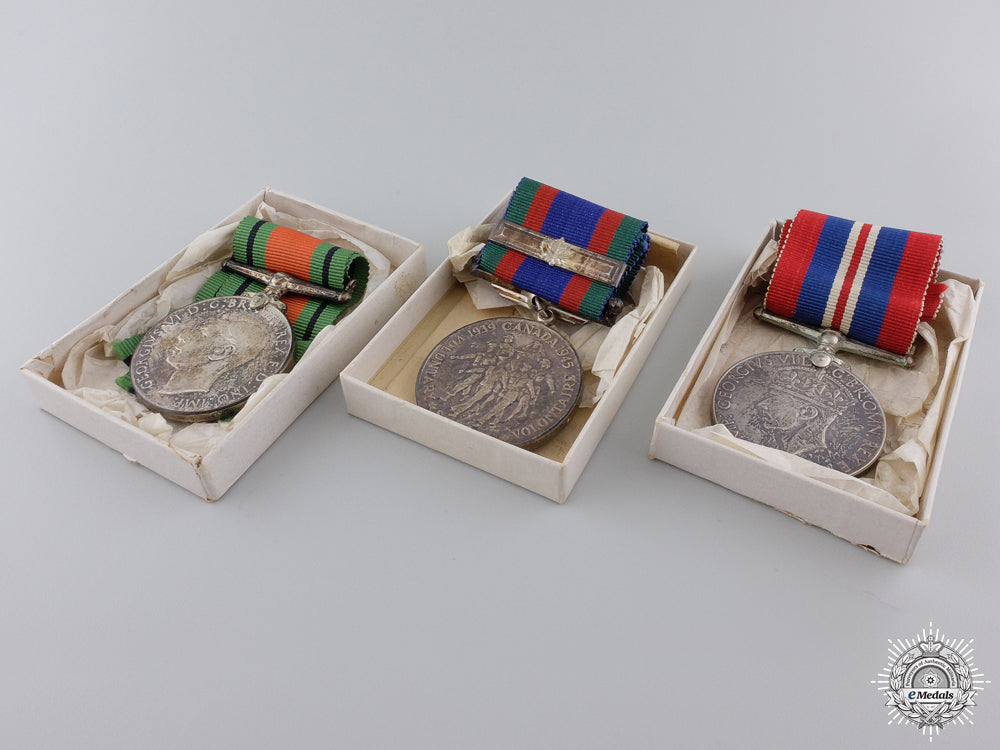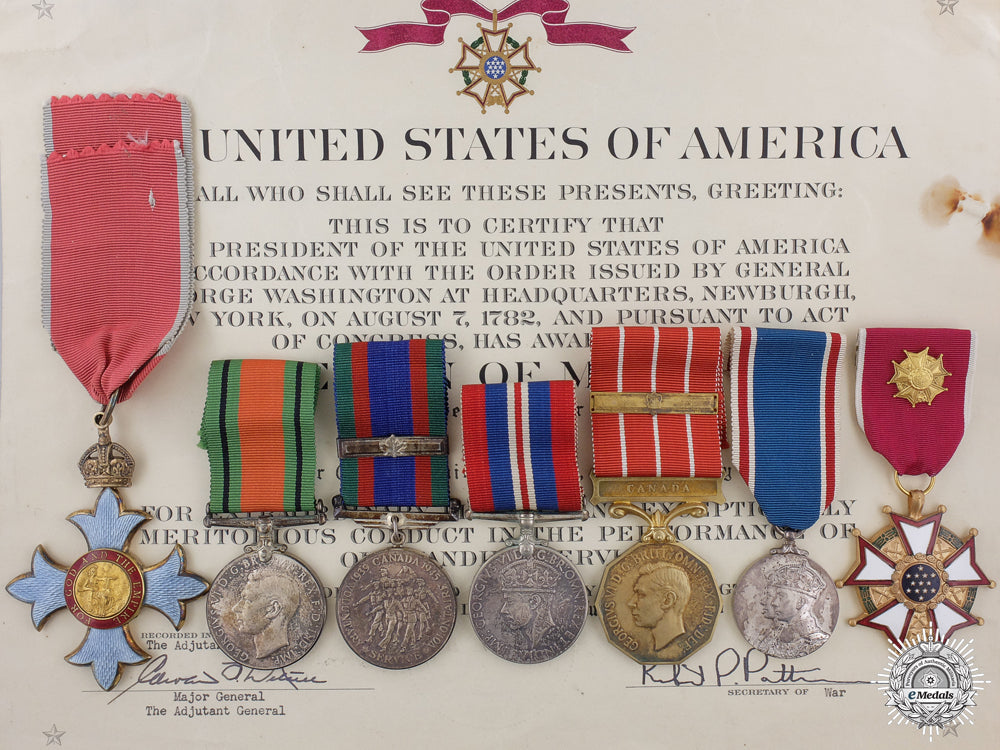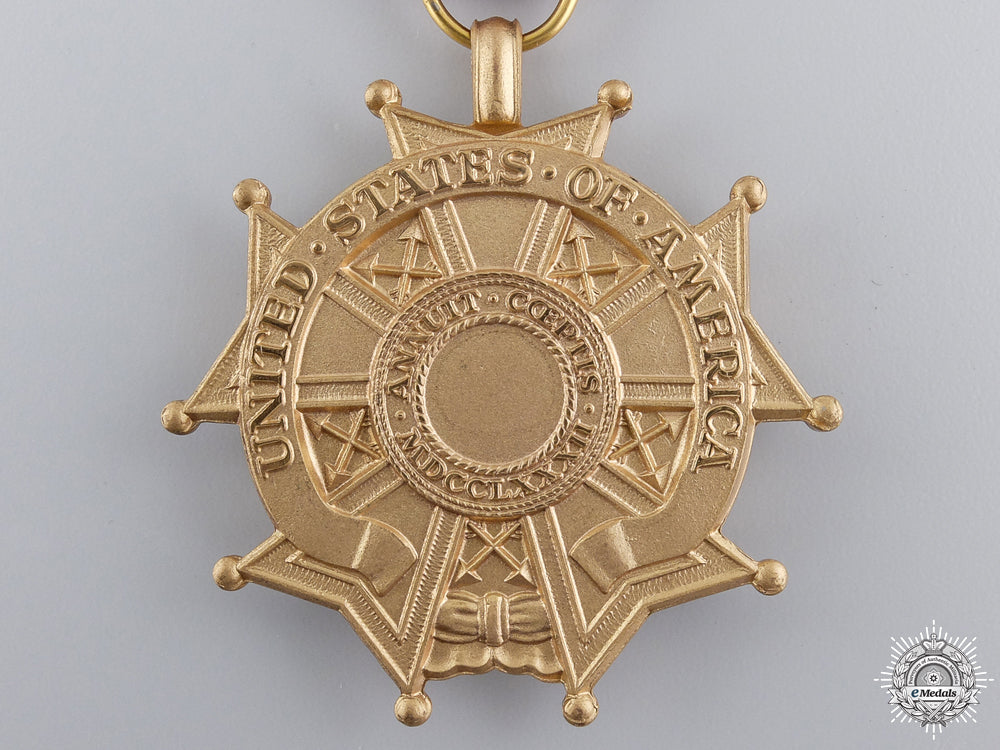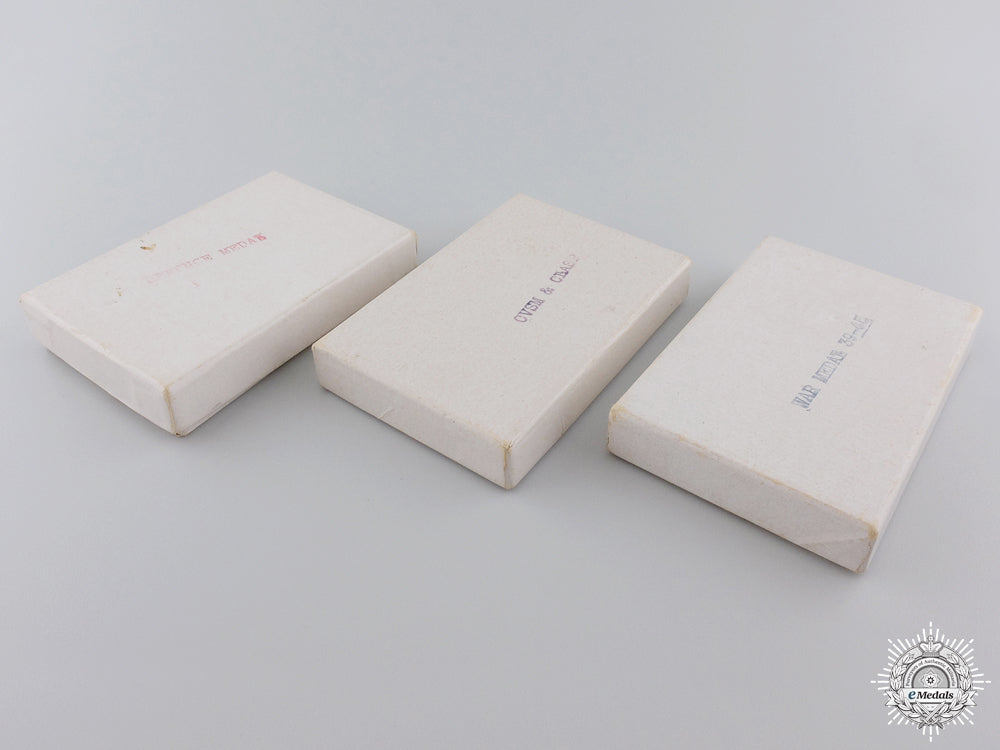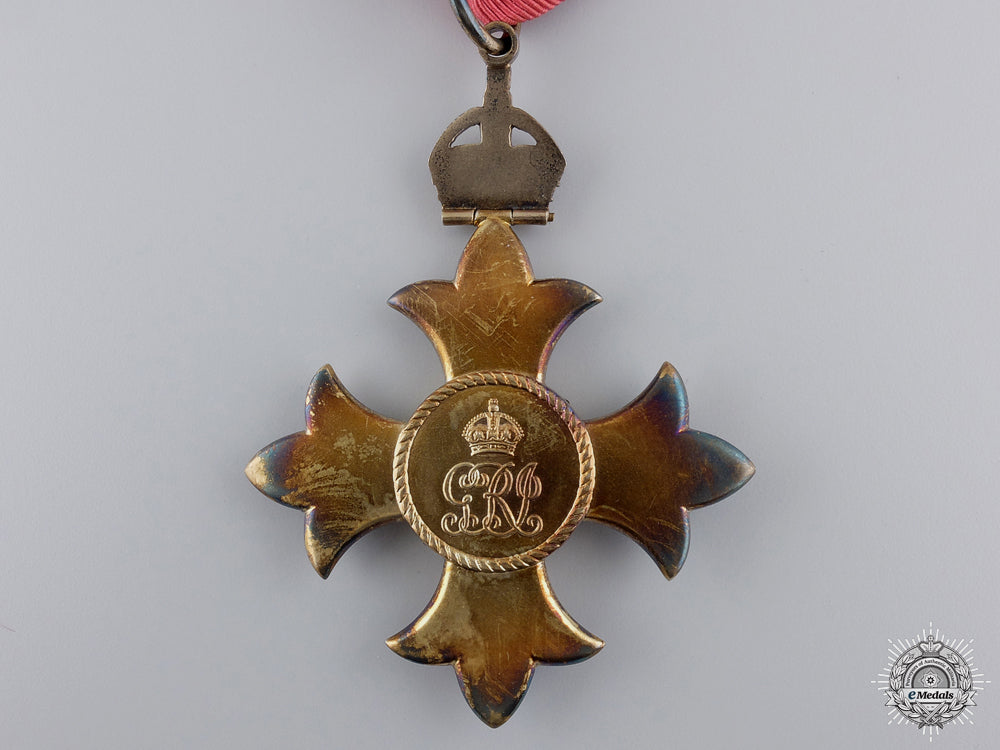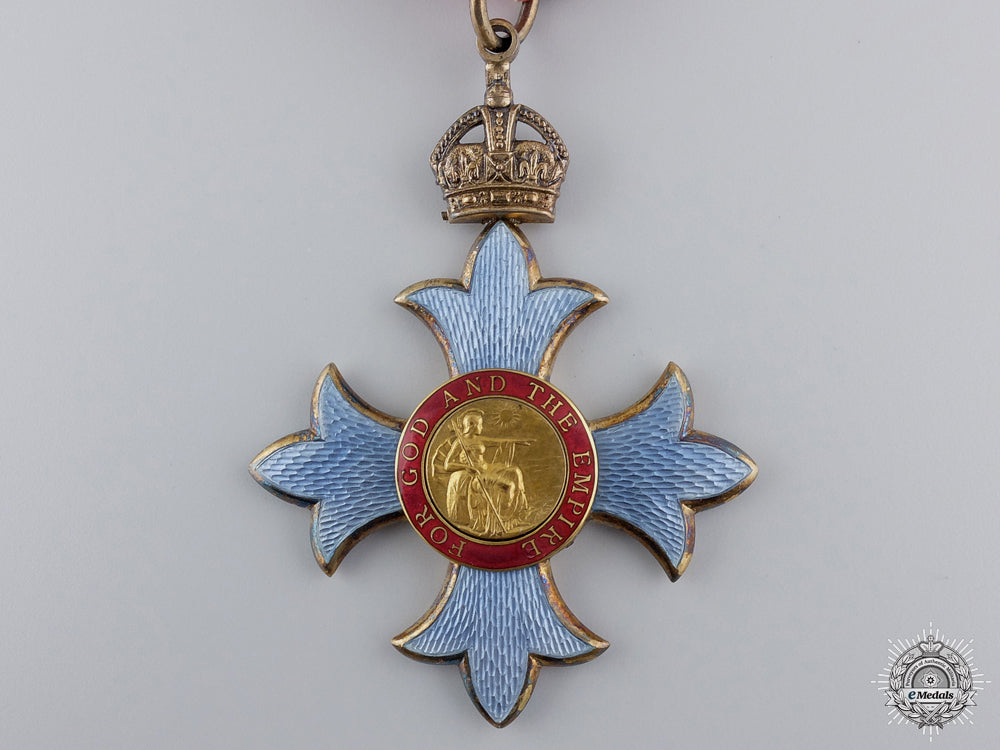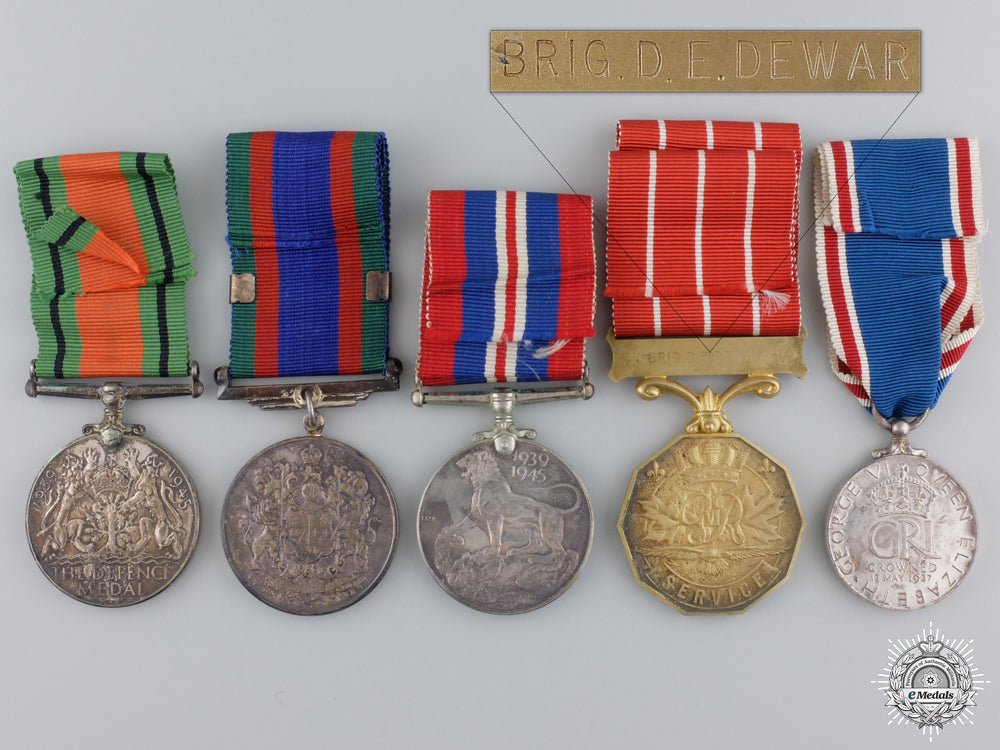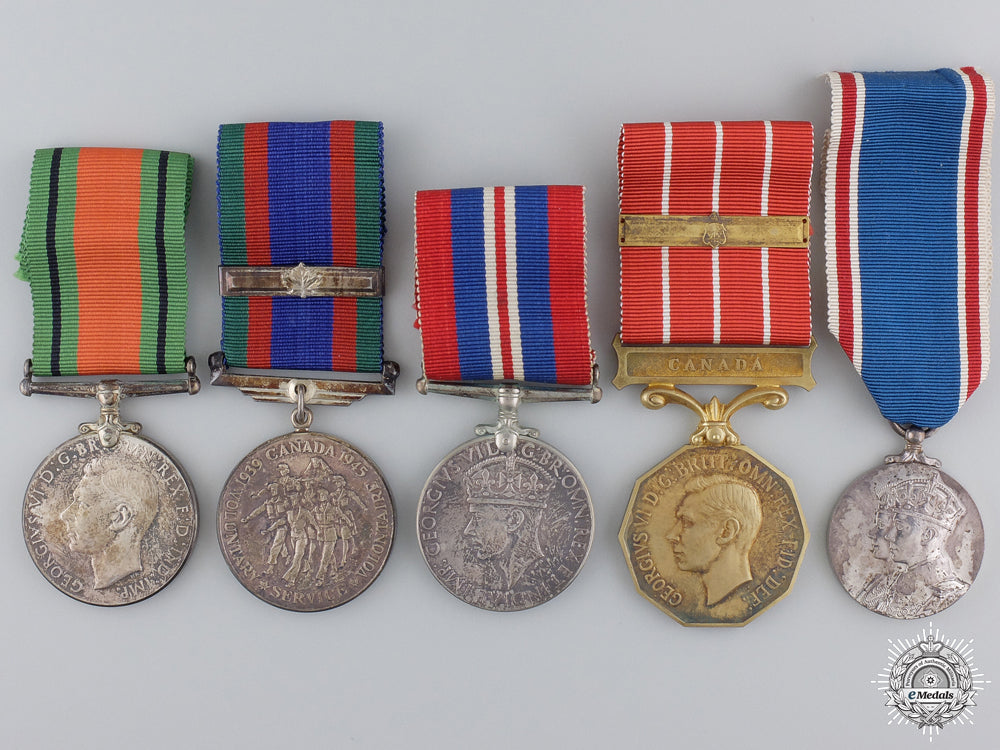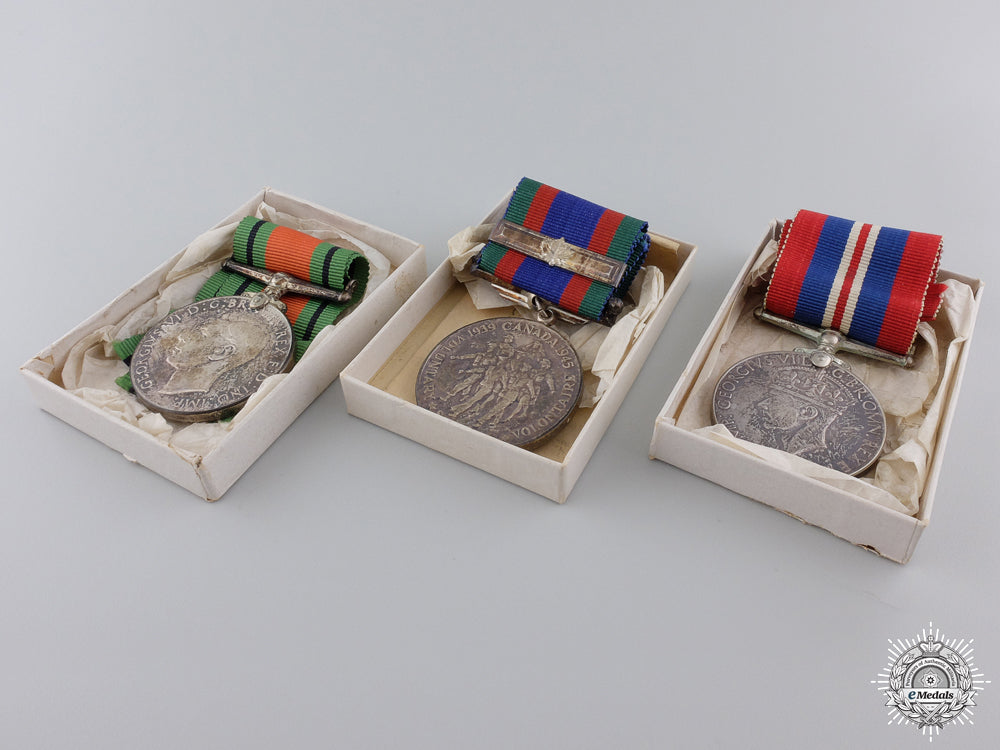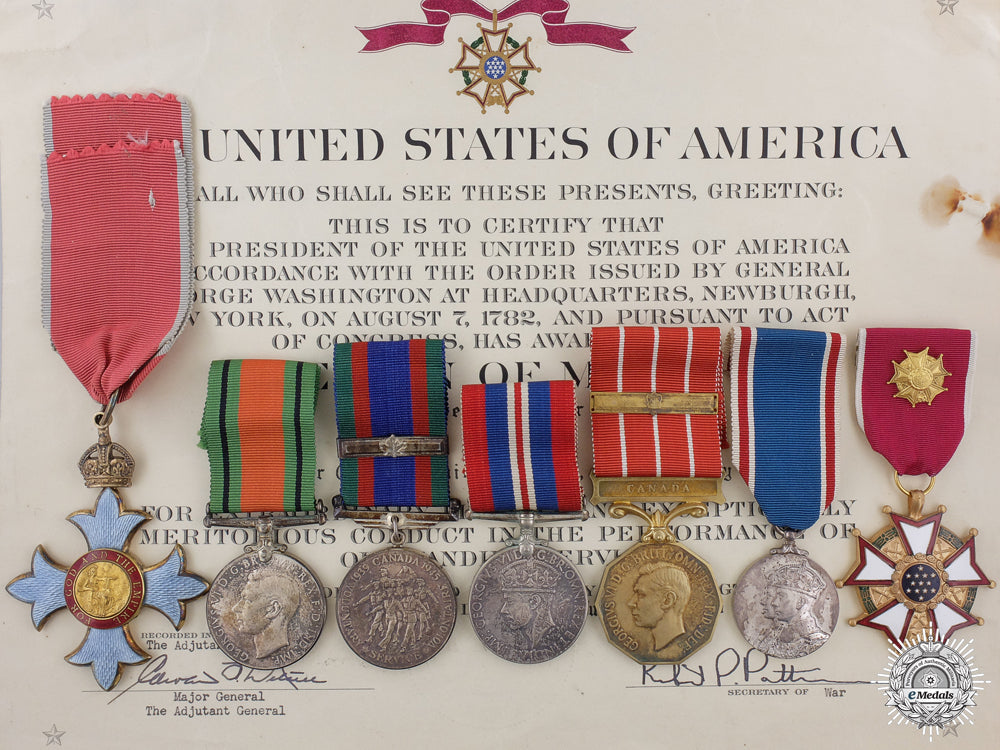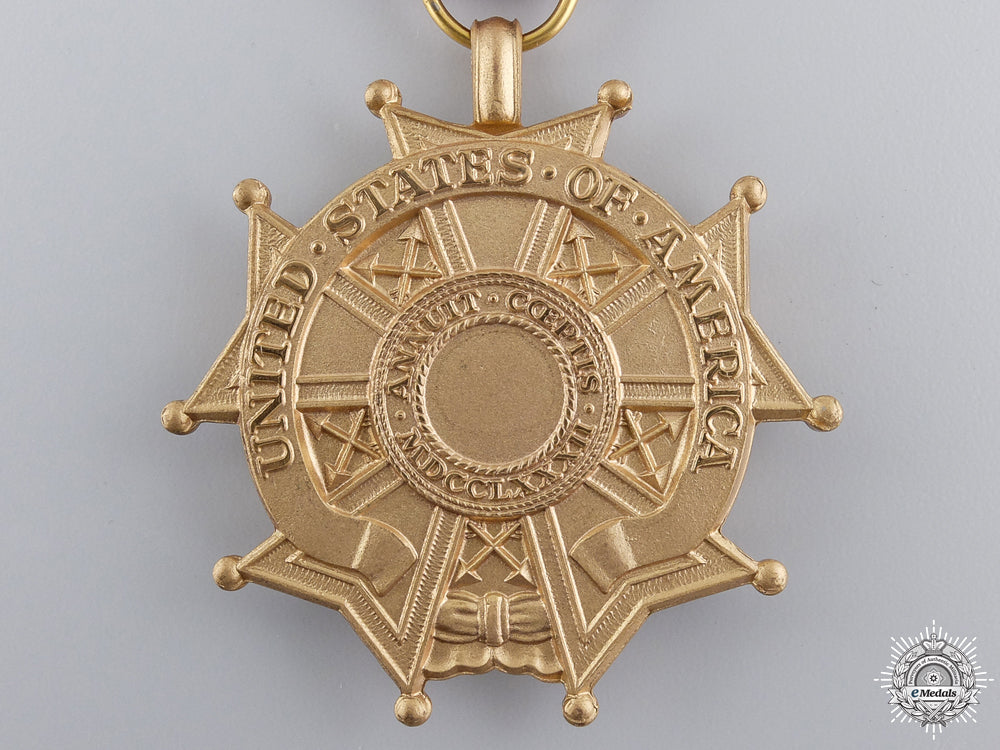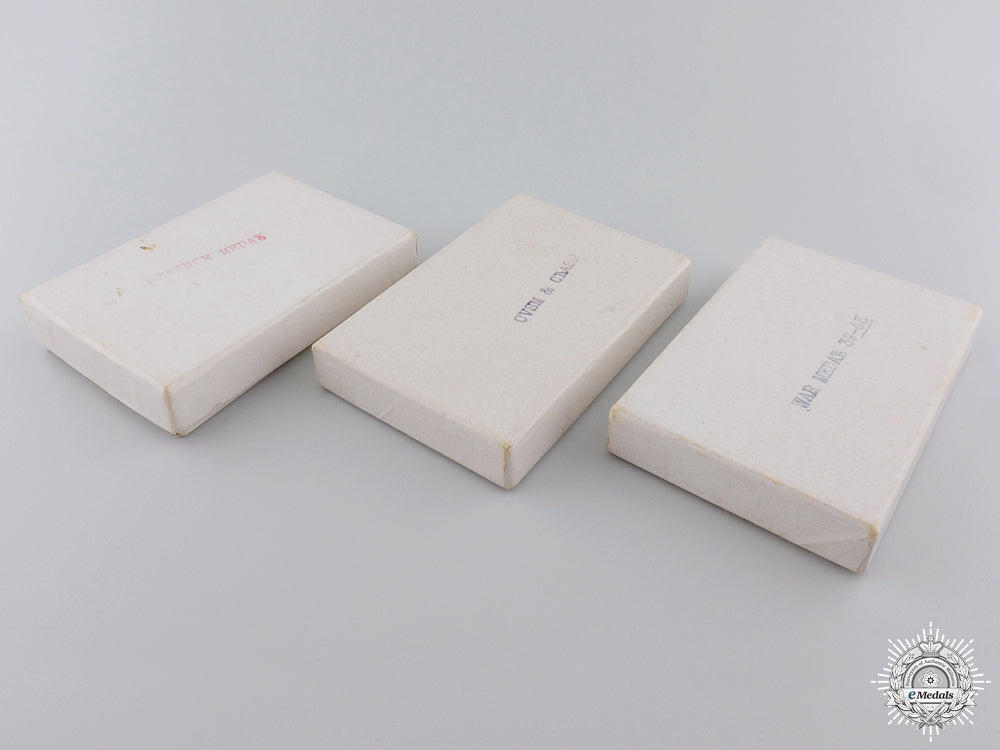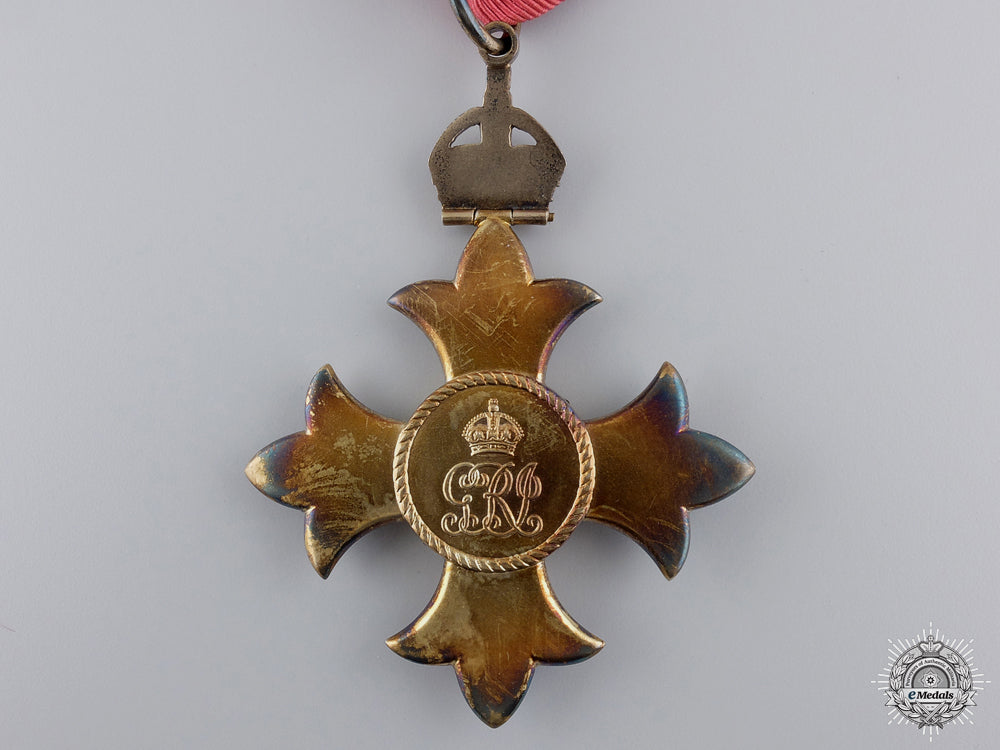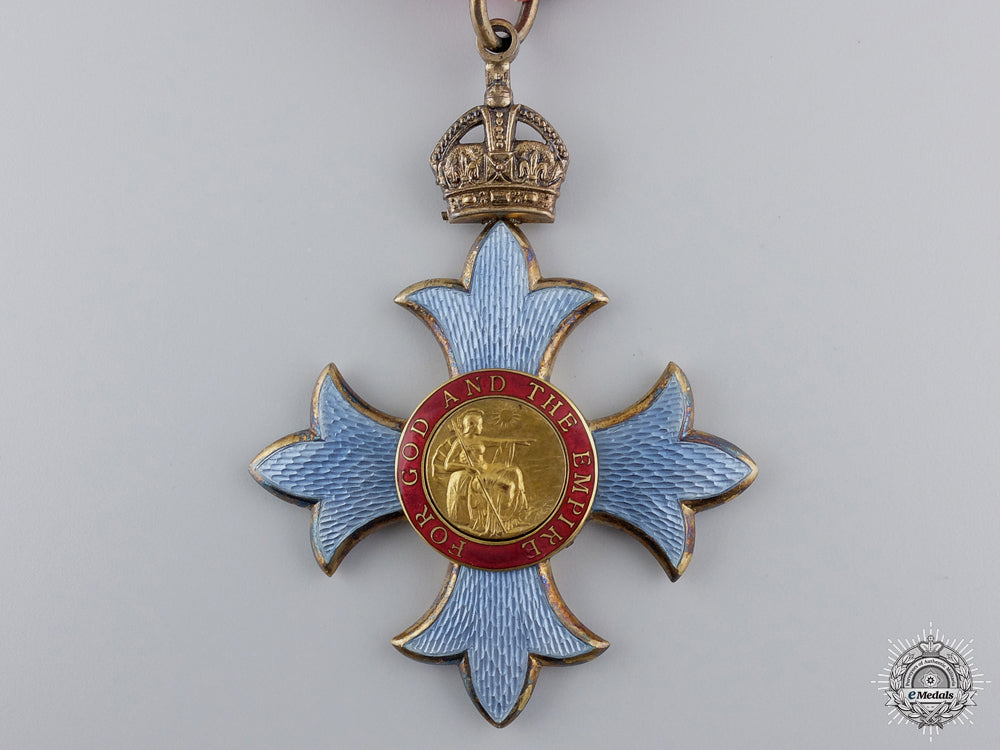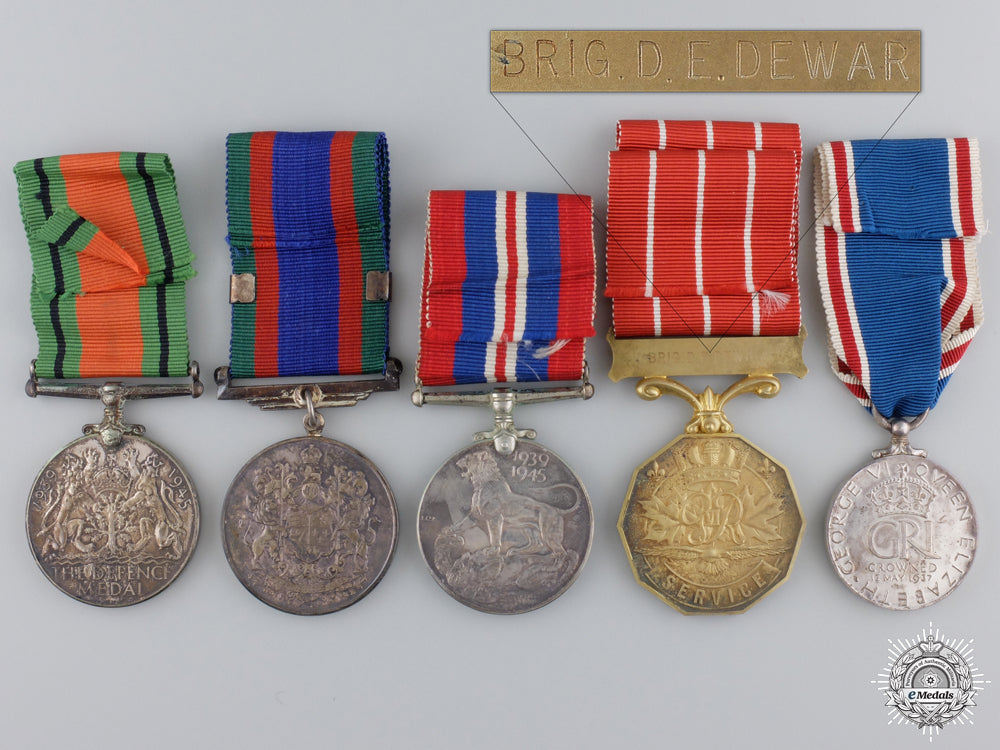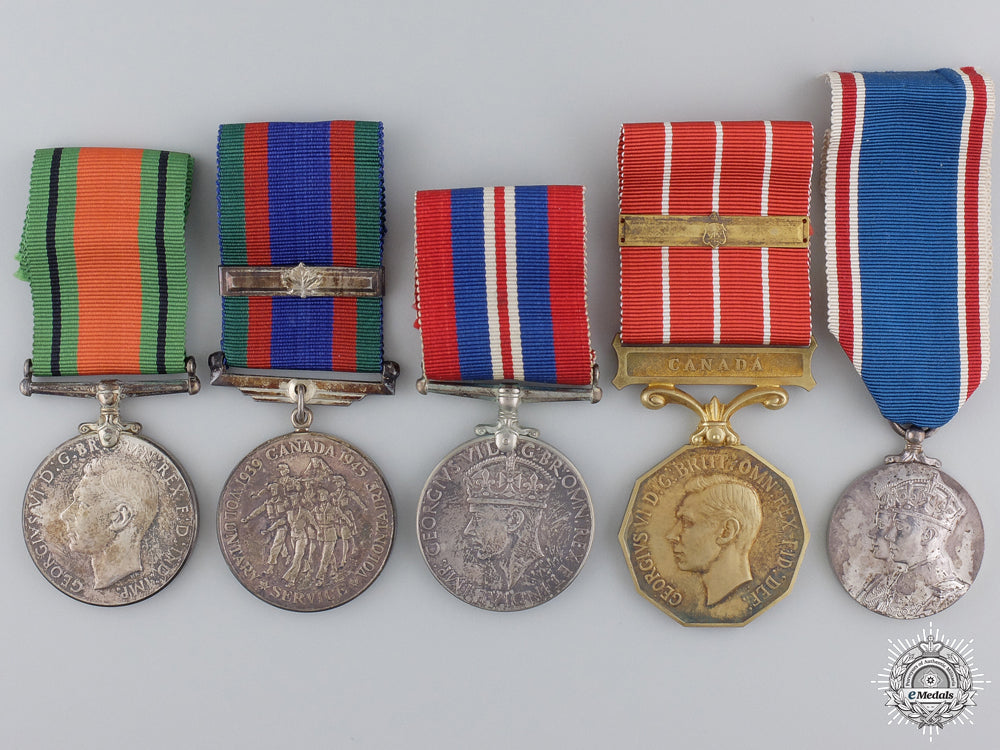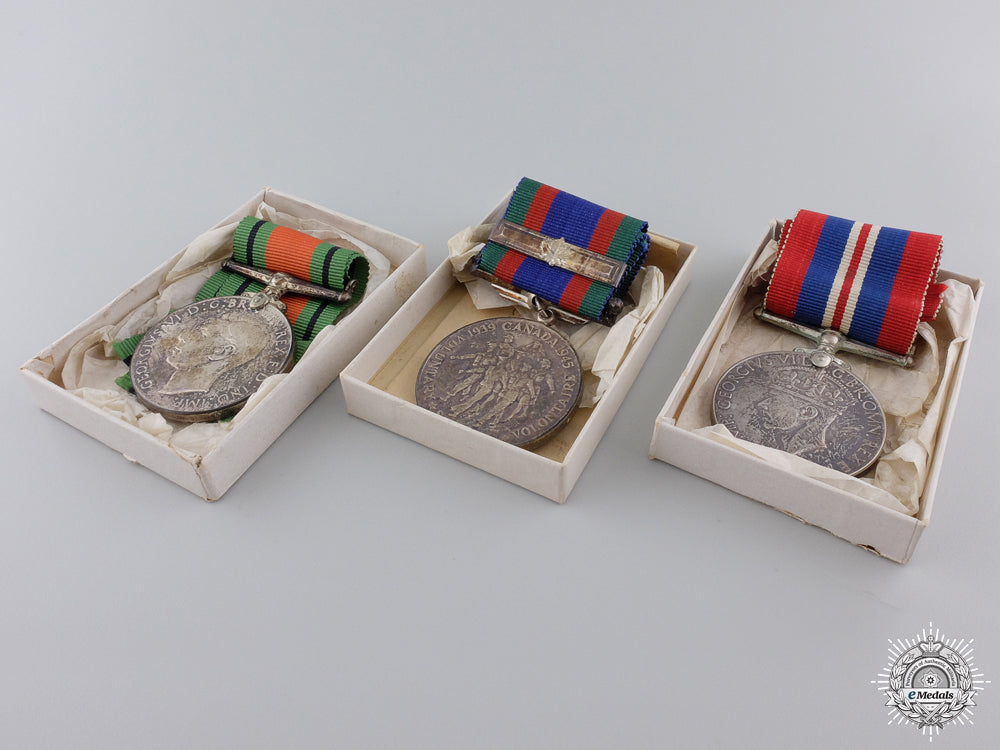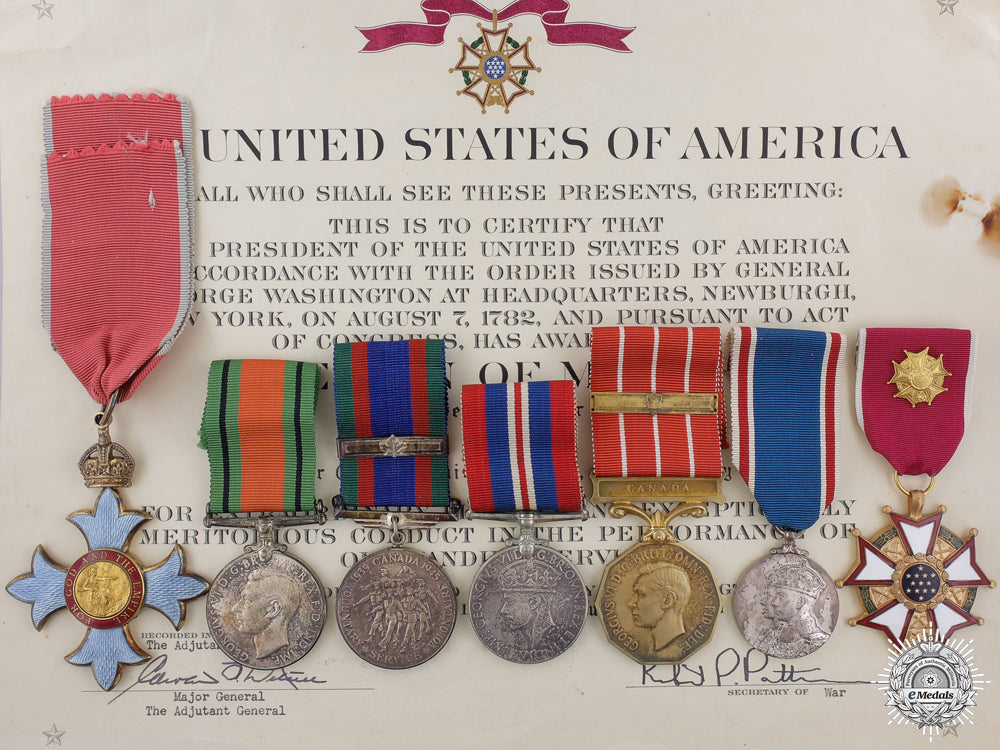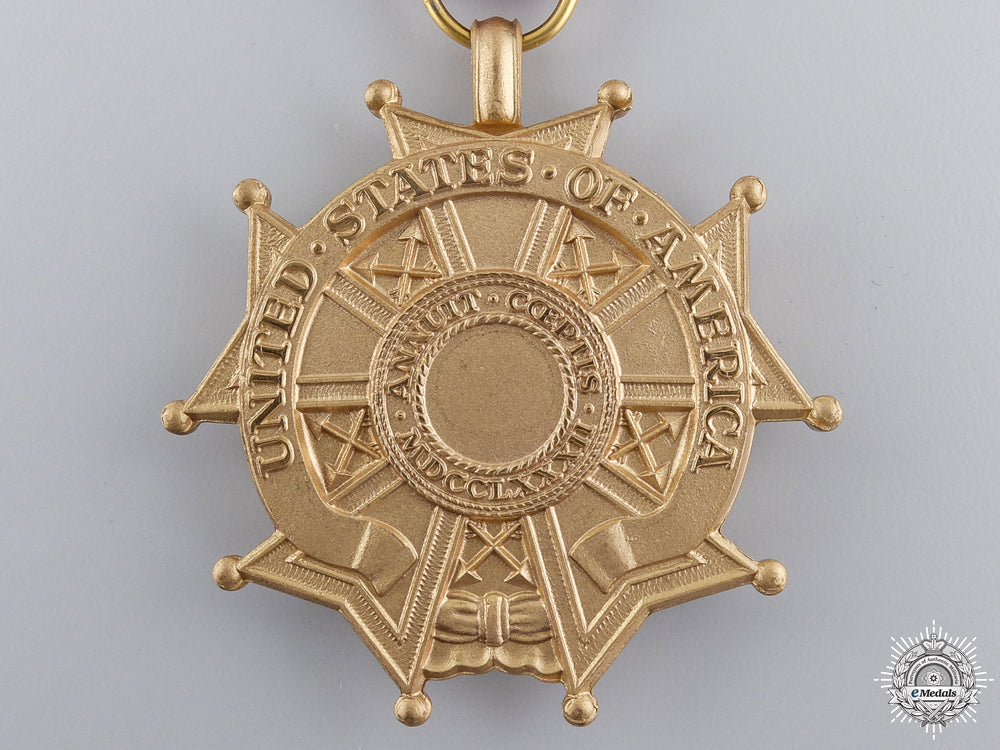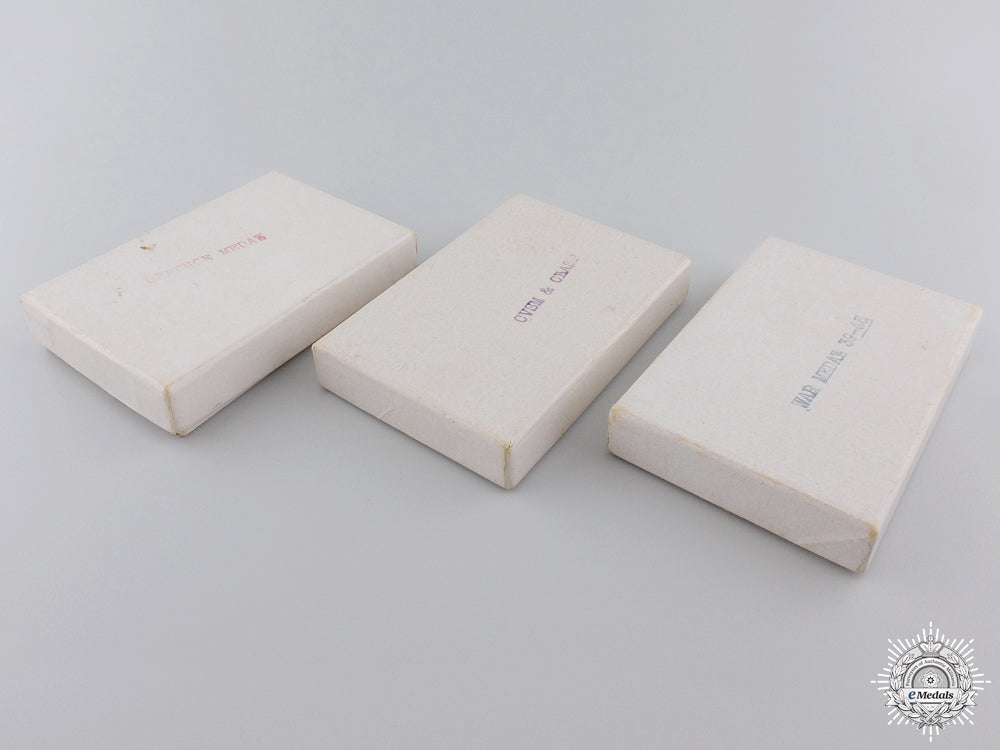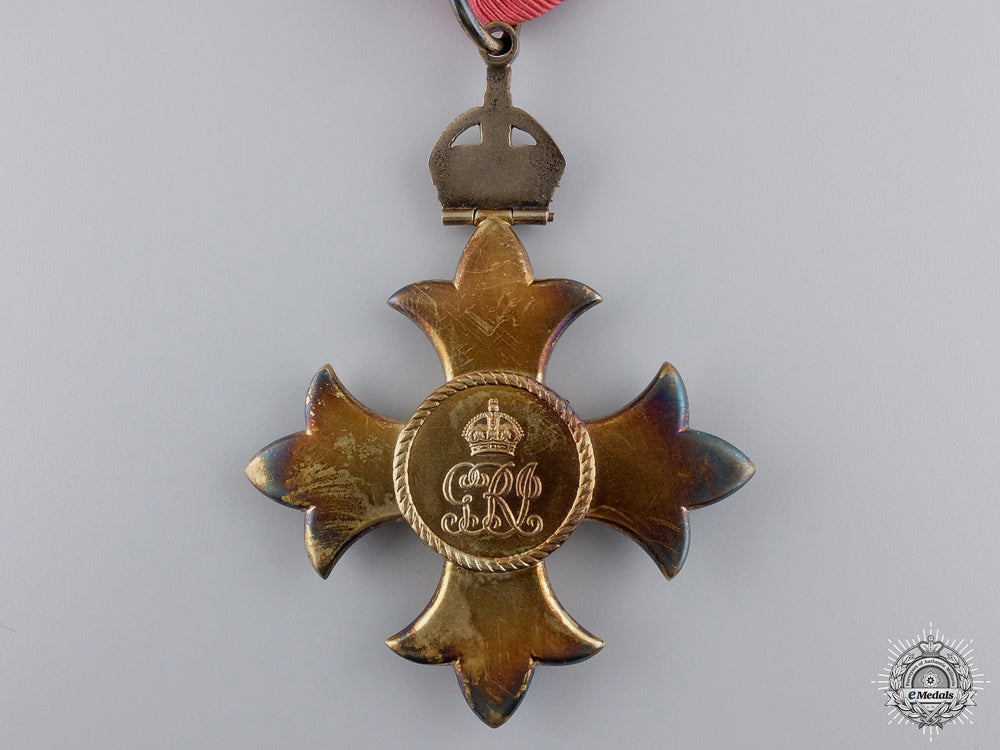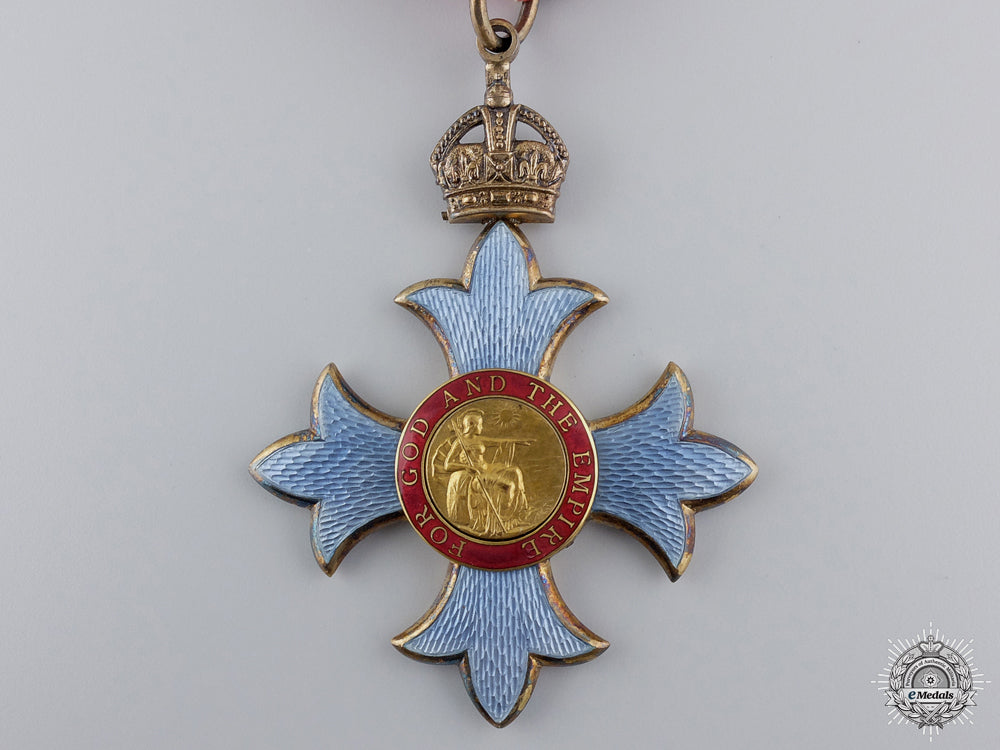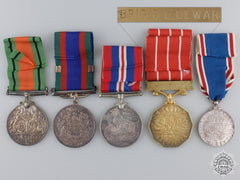Description
The Award of Major-General D.E.Dewar CBE CD; Canadian Army - Commander of the Order of the British Empire (CBE), Military Division (silver gilt and enamels, 61.8 mm x 78.5 mm, on second type Civil ribbon, light tarnishing on the reverse, cased, recessed medal bed inserted into a vacant interior); Defence Medal (silver, 36 mm, original ribbon, in its box of issue); Canadian Volunteer Service Medal with Overseas Clasp (silver, 36.5 mm, original ribbon, in its box of issue with clasp packet); War Medal 1939-1945 (silver, 36 mm, original ribbon, in its box of issue); Canadian Forces' Decoration, George VI (silver gilt, engraved "BRIG. D.E. DEWAR" on the reverse of the suspension, 38.7 mm, original ribbon, accompanied by two gilt ten years' additional service clasps in their Department of National Defence packets, it its hardshelled case of issue); Coronation Medal 1937 (silver, 31.7 mm, original ribbon, light tarnishing); United States: Legion of Merit, Officer (bronze gilt and enamels, 46.5 mm x 48.5 mm, gilt Officer device on the original ribbon, with pinback, accompanied by its 10 mm x 35.5 mm ribbon bar with gilt Officer device and pinback, in its hardshelled case of issue, inscribed "LEGION OF MERIT OFFICER" on the lid with a name tag inscribed "Dewar, Major General Daniel E." taped below); a 20 mm Mark II Shell Desk Ornament (brass shell, stamped "TR 1944 29 MM MK. II" on the bottom, 25 mm x 181 mm, attached to a dark gray upright standing frame named to "D.E. DEWAR" via a clear acrylic clip, stand measuring 97 mm x 140 mm x 70 mm); his George V Commission Document (numbered "23037", naming to Daniel Everett Dewar, Canadian Ordnance Corps to the rank of Lieutenant, Devonshire coat-of-arms emboss stamped, dated July 20, 1917, 310 mm x 365 mm, fold marks, light soiling); a Letter from Buckingham Palace Accompanying the Coronation Medal 1937 (named to "Lieutenant-Colonel Daniel Everett Dewar", 197 mm x 248 mm); his United States: Legion of Merit Award Document (named to "Major General Daniel E. Dewar, Canadian Army", awarding him the Legion of Merit, Degree of Officer, dated June 29, 1946, 250 mm x 303 mm, soiled); a Letter from the Department of National Defence, Army (addressed to Mrs. Dewar, dated June 21, 1946 at Ottawa, congratulating her husband and family on the award of the Commander of the Military Division of the Most Excellent Order of the British Empire, 202 mm x 254 mm); a Letter from the Department of National Defence, Army (addressed to Mrs. Dewar, dated August 15, 1946 at Ottawa, congratulating her husband and family on the award of the American Legion of Merit (Degree of Officer), conferred by President Truman); a Letter from the Department of National Defence, Army (addressed to Brigadier Dewar, dated July 27, 1950 at Ottawa, informing him of the creation of the Canadian Forces' Decoration and his award of such with two clasps, 204 mm x 242 mm, with mailing envelope addressed to "Brigadier D.E. Dewar, CBE, CD", postmarked July 31, 1950 at Ottawa, 104 mm x 241 mm); a Letter from the Department of National Defence, Army (addressed to Brigadier Dewar, dated July 17, 1951 at Ottawa, accompanying the two clasps to the Canadian Forces' Decoration, 202 mm x 240 mm); a Letter from the White House, Washington, D.C. with his Citation for the Legion of Merit, Degree of Officer (signature of President Harry Truman, 202 mm x 266 mm, paper clip soiling mark); a copy of his Citation for the Award of Commander of the British Empire; and copies of three Canadian Active Service Force papers (confirming his awarding of the Commander of the Order of the British Empire, the Grand Officer of the Order of the Orange-Nassau and the Canadian Forces' Decoration with two Clasps). Accompanied by three awards to his son, Donald James Dewar: Thorburn Prize for General Proficiency Medal (bronze, maker marked "BIRKS" on the edge, obverse illustrating a pensive seated woman, a globe to her left, her right hand holding a book, with various icons, inscribed "OTTAWA COLLEGIATE INSTITUTE" above and "ALERE FLAMMAN" (To Feed the Flame) below, reverse engraved "Glebe Collegiate Institute / General Proficiency / Class 3J / Donald J. Dewar / 1931", 50.7 mm, in its hardshelled case of issue, maker marked "BIRKS" on the inside lid, recessed medal bed, contact marks on the reverse); Thorburn Prize for General Proficiency Medal (bronze, maker marked "BIRKS" on the edge, obverse illustrating a pensive seated woman, a globe to her left, her right hand holding a book, with various icons, inscribed "OTTAWA COLLEGIATE INSTITUTE" above and "ALERE FLAMMAN" (To Feed the Flame) below, reverse engraved "Glebe Collegiate Institute / General Proficiency / Class 4K / Donald J. Dewar / 1932", 50.7 mm, in its hardshelled case of issue, recessed medal bed, contact marks on the reverse); a Queen's University Award for Chemistry Medal (bronze, obverse illustrating the Queen's University coat-of-arms surrounded by the inscription "QUEEN'S UNIVERSITY KINGSTON CANADA" reverse engraved "CHEMISTRY / DONALD J. DEWAR / 1937" inside an open-ended wreath, 41.3 mm, in its hardshelled case of issue, raised and recessed medal bed), along with a Newspaper Article from 1932 Entitled "Donald J. Dewar Makes Fine Record At Glebe School" (black ink on newsprint, 52 mm x 266 mm, yellowed). Near extremely fine.
Footnote: Daniel Everett Dewar was born on July 30, 1888, the son of Major and Mrs. D.E. Dewar. In late 1909, he began his military career and after nine years' service in the ranks (four years and 123 days) and as a Warrant Officer (two years and 92 days), he was named Honourary Lieutenant on January 1, 1915. Dewar was commissioned as a Lieutenant in the Canadian Ordnance Corps (Permanent Active Militia) on July 9, 1916, named a Captain on October 28, 1916, and served throughout the First World War (1914-1919). Although his Attestation Paper is not on retrieval file, he is acknowledged as having been part of the Canadian Expeditionary Force. He held the position of Deputy Assistant Director of Ordnance Supply, Canadian Training Area in England from November 29, 1918 to July 31, 1919 and was named to the rank of Brevet Major on December 1, 1919, to Temporary Major on April 1, 1930, to Brevet Lieutenant-Colonel on July 15, 1935, to Major on September 30, 1937 and Lieutenant-Colonel on July 21, 1938. During those inter-war years, he subsequently served in various important ordnance staff appointments in Canada, including holding the position of Director of Clothing, Equipment & Manufacturing Establishments as of September 30, 1937. Upon the outbreak of the Second World War in 1939, he held the rank of Lieutenant-Colonel and it was noted that "the value of his special qualifications in all matters relating to supplies and equipment was at once recognized and he was seconded to a very important appointment with the Department of Munitions and Supply in 1940", in which he served throughout the remainder of the war and that "Major-General Dewar's services both in Canada and overseas have been consistently of great value and he is considered worthy of high honour." He is on record as being Director-General of Small Arms Ammunition, Department of Munitions & Supply from 1940 to 1945 with the Canadian Army, retiring in 1945, at the age of 57. He was awarded the Defence Medal, Canadian Volunteer Service with Overseas Clasp and War Medal 1939-1945 for his Second World War service. He continued to rise in the ranks, as he was named Brigadier (Acting Major General), the rank he held when he was awarded the Commander of the Order of the British Empire (CBE), Military Division, as published in the Supplement to the London Gazette on June 13, 1946, page 2824 and in the Canada Gazette on June 15, 1946, page 3843: "The KING has been graciously pleased, on the occasion of the celebration of His Majesty's birthday, to give orders for the following appointments to and promotions in the Most Excellent Order of the British Empire". His citation for the CBE reads: "This officer has served his country faithfully for many years. After nine years service in the ranks and as a Warrant Officer, he was commissioned as a Lieutenant in the Canadian Ordnance Corps (Permanent Active Militia) in 1916. He served throughout the war 1914-1919 and at the termination was a Brevet Major. He subsequently served in various important ordnance staff appointments in Canada and on the outbreak of war in 1939 was holding the rank of Lieutenant-Colonel. The value of his special qualifications in all matters relating to supplies and equipment was at once recognized and he was seconded to a very important appointment with the Department of Munitions and Supply in 1940 in which he served throughout the remainder of the war. Major-General Dewar's services both in Canada and overseas have been consistently of great value and he is considered worthy of high honour." In an article in the Canberra (Australia) Times on Friday, April 8, 1949, it described the upcoming award ceremony: "Brigadier Daniel Everett Dewar of the Canadian Army, will be presented with the Warrant and Insignia of Commander of the Order of the British Empire by High Commissioner for Canada, Mr. K.A. Greene, O.B.E., at a brief ceremony in Melbourne next Saturday. Brigadier Dewar, who held the acting rank of Major-General during the war, and Mrs, Dewar have spent the past 18 months in Australia visiting their daughter, Mrs. William Eades, of Melbourne, and travelling extensively in the Commonwealth." He was later to hold the rank of Major-General when he was awarded the United States: Legion of Merit (Degree of Officer), "for extraordinary fidelity and exceptionally meritorious conduct in the performance of outstanding service". His citation for the award from the White House in Washington, D.C., signed by President Harry Truman reads: "Major General Daniel E. Dewar rendered exceptionally meritorious service as Director General of Small Arms Ammunition, Canadian Government Department of Munitions and Supply, and as Chairman, Canadian Section, Small Arms Ammunition Sub Committee, Canada and the United States, during the period December 1941 to June 1945. He gave valuable assistance to the United States in connection with small arms ammunition supply. The results General Dewar obtained were a demonstration of the effectiveness of Canadian-American cooperation in winning total victory." In addition, he was awarded the Netherlands: Grand Officer of the Order of Orange-Nassau with Swords, by Royal Decree No. 29 on November 11, 1946, as published in the Canada Gazette on February 15, 1947, page 570, "The KING has been pleased to grant unrestricted permission for the wearing of the following decorations which have been conferred upon the undermentioned in recognition of distinguished services in the cause of the Allies" with the notation "DECORATIONS CONFERRED BY HER MAJESTY THE QUEEN OF THE NETHERLANDS" (Queen Wilhelmina), the award having been lost to time and not included with this group. For his long and distinguished service in the Canadian Army, Dewar was awarded the newly created Canadian Forces' Decoration for twelve years' service. In addition, he was awarded two Clasps, each representing ten years' additional service, all three of which were issued on October 2, 1950. His son, Daniel J. Dewar followed in his father's footsteps and was academically gifted, as he proved in his latter high school years at Glebe Collegiate in Ottawa, Ontario, being awarded the Thorburn Prize for General Proficiency, twice, in 1931 and 1932, as evidenced by the two awards accompanying his father's group. In a newspaper article from 1932 entitled "Donald J. Dewar Makes Fine Record At Glebe School", it stated that he "carried off the lion's share of academic prizes in the upper school at Glebe Collegiate in the examinations just concluded. Young Dewar in addition to capturing the Thorburn prize for general proficiency, stood first in mathematics, first in French, and first in Latin. He also won the medal for Form V-C and the Student Council first prize in mathematics and second prize in science. Dewar will attend Queen's University, Kingston, next fall, likely enrolling in the science course." After graduating from Glebe Collegiate, he attended Queen's University in Kingston, Ontario and was awarded the Queen's University Award for Chemistry Medal in his graduating year of 1937.

